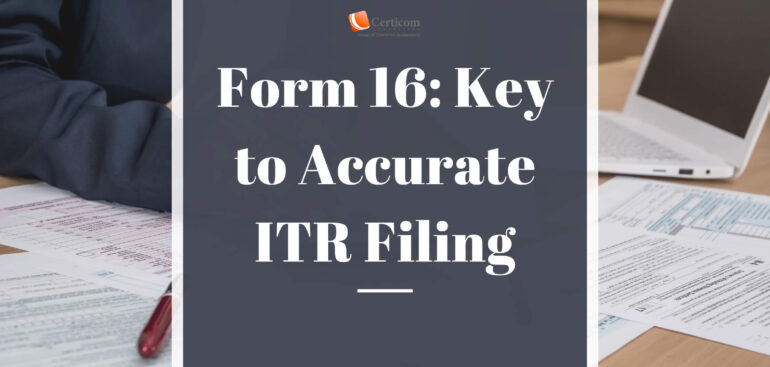Form 16: Key to Accurate ITR Filing

As tax season rolls in, salaried individuals across India are bracing themselves for the annual ritual of Income Tax Return (ITR) filing. With numerous documents to gather and deadlines looming, one document emerges as a true ally—Form 16. Often overlooked or misunderstood, Form 16 is much more than just a routine TDS certificate—it’s your personal tax blueprint, designed to simplify your return filing and safeguard you from errors, mismatches, and tax notices.
What Exactly Is Form 16—and Why Does It Matter So Much?
Form 16 is issued annually by your employer, certifying that TDS (Tax Deducted at Source) has been deducted from your salary and deposited with the government. For the financial year 2024–25, most employees would have received it by mid-June 2025.
But beyond confirming TDS, Form 16 plays a bigger role—it summarizes your income, tax-saving claims, deductions, and total tax liability for the year. It’s an official validation of your salary and tax details, making it a must-have for filing an accurate ITR.
In specific cases, senior citizens aged 75 or above who receive pension and interest income from the same bank may receive a similar consolidated certificate from the bank or financial institution.

The Structure of Form 16: What’s Inside
Form 16 is issued annually by your employer, certifying that TDS (Tax Deducted at Source) has been deducted from your salary and deposited with the government. For the financial year 2024–25, most employees would have received it by mid-June 2025.
But beyond confirming TDS, Form 16 plays a bigger role—it summarizes your income, tax-saving claims, deductions, and total tax liability for the year. It’s an official validation of your salary and tax details, making it a must-have for filing an accurate ITR.
In specific cases, senior citizens aged 75 or above who receive pension and interest income from the same bank may receive a similar consolidated certificate from the bank or financial institution.
The Structure of Form 16: What’s Inside
Form 16 has two main parts:
🔹 Part A – The Identification Section
This part includes:
Your name, PAN number
Employer’s TAN and name
Total salary paid
TDS deducted and deposited
It acts as a record of who you are, who your employer is, and whether your taxes have been paid.
🔹 Part B – The Tax Computation Summary
This section is crucial for ITR filing. It outlines:
Gross salary and income
Exemptions like HRA, LTA
Deductions under Sections 80C, 80D, etc.
Net taxable income and final tax liability
🔹 Form 12BA – The Perquisite Breakdown
If you received any perks, ESOPs, or non-cash benefits, these are disclosed in Form 12BA, which often accompanies Form 16. Omitting these details while filing returns can result in a mismatch with Form 26AS or the AIS (Annual Information Statement), possibly inviting scrutiny or notices from the tax department.
What Should You Double-Check in Form 16 Before Filing Your ITR?
Taking Form 16 at face value can be risky. Make sure to review it thoroughly:
✅ Personal & Employer Details: Confirm your PAN, name, and your employer’s TAN are correct—typos here can cause return processing failures.
✅ Salary Figures: Cross-check with your salary slips to ensure the breakup and total income match.
✅ Tax-Saving Claims: Ensure exemptions like HRA, LTA and deductions under Section 80C/80D are accurately reported.
✅ TDS Amounts: Match the TDS details in Form 16 with Form 26AS and AIS to spot discrepancies in advance.

Why Form 16 Matters Even More in FY 2024–25
This year, the ITR filing deadline has been extended to September 15, 2025—giving taxpayers more time to file returns correctly. But more time also means more responsibility to ensure accuracy.
A single error in interpreting Form 16 could trigger:
A demand for additional tax
Delay in refunds
Income mismatch notices from the IT department
Hence, don’t treat Form 16 as just another PDF. Treat it like your tax toolkit.
Make Form 16 Work for You
Before hitting the “submit” button on your ITR, spend quality time understanding your Form 16. It isn’t just a compliance document—it’s your income tax superpower. Used properly, it ensures:
You declare your income accurately
You claim the deductions you’re entitled to
You avoid unnecessary taxes or scrutiny
Filing your ITR isn’t just a legal formality—it’s key to protecting your finances. Form 16 is your first line of defense—reach out to Certicom for expert guidance.
Related Post
Form 16: Key to Accurate ITR Filing
Cost Inflation Index for FY 2025-26: Impact on LTCG Tax
Loan Interest Deductions: How to Claim and Avoid Tax Scrutiny
Book A One To One Consultation Now For FREE
How can we help? *










